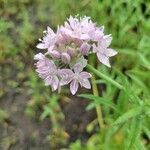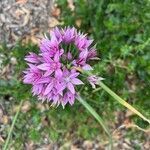Bulbs solitary, replaced annually by new bulbs borne terminally on secondary rhizome; rhizomes 1–3, conspicuous, to 5 cm, smooth; parent bulbs disappearing by anthesis except for still-functional roots and bulb coat, ovoid to oblique-ovoid, 1–2 × 0.8–1.5 cm; outer coats not enclosing bulbs, pale brown, delicately cellular-reticulate, membranous, cells ± rectangular, without fibers; inner coats white, cells obscure, ± transversely elongate, contorted. Leaves persistent, green or withering from tip at anthesis, 2–3, basally sheathing, sheaths not extending much above soil surface; blade solid, flattened, sometimes carinate abaxially, ± falcate, 18–50 cm × 4–10 mm, margins entire. Scape persistent, solitary, erect, solid, terete, 20–80 cm × 2–7 mm. Umbel persistent, erect, loose, 15–35-flowered, hemispheric, bulbils unknown; spathe bracts persistent, 2, 6–8-veined, lance-ovate to broadly ovate, ± equal, apex acuminate. Flowers stellate, 11–15 mm; tepals spreading, bright pink or rarely white, obovate to ovate, unequal, becoming papery and connivent over capsule, margins entire, apex acute to obtuse or emarginate, inner shorter and narrower than outer; stamens included; anthers yellow or purple; pollen yellow or gray; ovary crestless, 3-grooved, with thickened ridge on either side of groove; style linear, equaling stamens; stigma capitate, scarcely thickened, unlobed or obscurely 3-lobed; pedicel 15–40 mm. Seed coat dull; cells minutely roughened. 2n = 14.
More
An onion family plant. It is a bulb plant. It grows 40-60 cm high and spreads 20-30 cm wide. The leaves are blue-green and flat. They have an easy to see central midrib. The leaves are 30 cm long and there is one leaf per bulb. The flowers are bell shaped and pink. They are in rounded heads.
Moist soils in pine or mixed evergreen forest in the coastal ranges of California. Moist, clay soils, including serpentine, usually along streams; at elevations up to 1,100 metres.
More
It suits hardiness zones 8-10.
Can be grown by divisions or seedlings. Seeds needs stratification.


